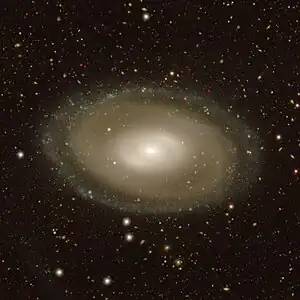| NGC 1079 | |
|---|---|
 | |
| Observation data (J2000 epoch) | |
| Right ascension | 02h 43m 44.3s[1] |
| Declination | −29° 00′ 12″[1] |
| Redshift | 0.004843 ± 0.000017 km/s[2] |
| Distance | ~61,5 Mly[2] (18.8 ± 1.3 Mpc) |
| Apparent magnitude (V) | 11.5[2] |
| Apparent magnitude (B) | 12.4[2] |
| Surface brightness | 14.4 mag/arcmin2[2] |
| Characteristics | |
| Apparent size (V) | 5.50 x 3.1 arcmin[2] |
| Other designations | |
| ESO 416-13, MCG -5-7-17, IRAS02415-2913, PGC 10330 | |
NGC 1079 is an isolated, weakly barred, grand-design spiral galaxy with transitional ring-like structures[3] containing a number of prominent A type stars.[1] It is located in the Fornax constellation and is part of the Eridanus supercluster.[4] It was first observed and catalogued by the astronomer John Herschel in 1835.[5]
Characteristics
NGC 1079 has unique characteristics when compared to other galaxies with a similar luminosity. Its H l content per unit blue luminosity is three times higher. Its mass and rotation velocity is twice as large as normal and it has a low surface brightness in its spiral arms, exterior to a high surface brightness center dominated by old stars. A study[6] suggests these characteristics occur due to a luminous matter deficiency relative to its dynamical mass within the Holmberg radius.
Ring structure and star formation
Astronomers first identified NGC 1079's ring structure in 1996 by studying its HST ultraviolet imaging.[7] Later studies have shown virtually all the star-formation activity in this galaxy occurs inside the ring.[8]
See also
Other galaxies with star-forming rings include:
References
- 1 2 3 "NED search result for NGC 1079". ned.ipac.caltech.edu. Retrieved 2023-11-28.
- 1 2 3 4 5 6 "SEDS search result for NGC 1079". spider.seds.org. Retrieved 2023-11-28.
- ↑ de Vaucouleurs, G. (1963-04-01). "Revised Classification of 1500 Bright Galaxies". The Astrophysical Journal Supplement Series. 8: 31. doi:10.1086/190084. ISSN 0067-0049.
- ↑ Brough, S.; Forbes, D. A.; Kilborn, V. A.; Couch, W.; Colless, M. (2006-07-01). "Eridanus - a supergroup in the local Universe?". Monthly Notices of the Royal Astronomical Society. 369 (3): 1351–1374. arXiv:astro-ph/0603778. doi:10.1111/j.1365-2966.2006.10387.x. ISSN 0035-8711.
- ↑ "New General Catalog Objects: NGC 1050 - 1099". cseligman.com. Retrieved 2023-11-29.
- ↑ Gallagher, J. S.; Bushouse, H. (1983-01-01). "Optical studies of HI-rich southern galaxies. II. The low- visibility spiral NGC 1079". The Astronomical Journal. 88: 55–61. doi:10.1086/113286. ISSN 0004-6256.
- ↑ Maoz, D.; Barth, A. J.; Sternberg, A.; Filippenko, A. V.; Ho, L. C.; Macchetto, F. D.; Rix, H. -W.; Schneider, D. P. (1996-06-01). "Hubble Space Telescope Ultraviolet Images of Five Circumnuclear Star-Forming Rings". The Astronomical Journal. 111: 2248. arXiv:astro-ph/9604012. doi:10.1086/117960. ISSN 0004-6256.
- ↑ Böker, Torsten; Falcón-Barroso, Jesús; Schinnerer, Eva; Knapen, Johan H.; Ryder, Stuart (2008-02-01). "A SINFONI View of Galaxy Centers: Morphology and Kinematics of Five Nuclear Star Formation-Rings". The Astronomical Journal. 135: 479–495. arXiv:0710.4036. doi:10.1088/0004-6256/135/2/479. ISSN 0004-6256.